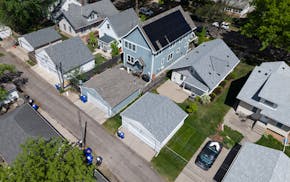Patients are waiting 38 days on average to see doctors in the Minneapolis area, which ranked fourth-worst for appointment delays in a study of 15 U.S. metro areas with physician shortages.
Delays varied by specialty — from 12 days for patients seeking routine physicals with family doctors to 87 days for those seeking screenings with dermatologists — but the survey by AMN Healthcare found waits are getting worse.
"It's a problem," said Jeff Decker, president of the physician staffing division at AMN, which has conducted six surveys of clinic wait times since 2004. "With cardiology, for example, if you wait a month (or) you wait three months, you can have a real problem. You could end up with emergent care situations."
Cardiology wait times in the Minneapolis area increased from 15 days in AMN's 2004 survey to 38 days this year. Minneapolis' performance in the survey has varied over two decades, but researchers said its longer wait times in 2025 compared with other cities could reflect a supply-demand imbalance as aging Minnesotans need more care while physicians retire.
The survey has limitations, focusing on the availability of in-person visits with physicians in an era of increasing online visits and usage of nurse practitioners and physician assistants to expand clinical care. Minnesota's large health systems have leaned on both of those strategies to compensate for physician shortages, which isn't reflected in the data.
The results also were self-published by a staffing agency with an interest in promoting its role in fixing those shortages.
But many Minnesotans relate to the trends it revealed. More than 300 people responded in 24 hours to the Minnesota Star Tribune's social media post about the survey, many of them upset with appointment delays.
One responder said "87 days for a dermatologist is quick!" after seeking an appointment in mid-April at any HealthPartners clinic and finding nothing for at least 270 days. Another said he had to wait five months to see a cardiologist — an unnerving delay, even if his suspicion was correct that he had only a minor cardiac issue.
Others reported delays across rural Minnesota and for other clinicians.
Rebecca Homard couldn't get an appointment with a Fairview dietitian until her fifth month of pregnancy this March, even though her midwife recommended one in December to structure her vegan diet in a way that would ensure nutrients for the baby.
Then a conflict came up on the day of the long-awaited visit. The next opportunity wasn't until July. The 28-year-old St. Paul woman is scheduled to give birth in June.
"So, no dietitian for me during pregnancy," she lamented.
Some patients give up in frustration.
Tim Carew got a referral from one HealthPartners clinic to another to assess him for ADHD. He suspected that he had lived with the condition for years, but it was starting to affect him in ways problematic for a 52-year-old nurse.
The Bloomington man was prepared to wait months, but he was shocked when the clinic scheduler had no openings for an adult assessment.
"As a nurse, I know it's hard to get in," he said. "They basically told me that I can't get in."
Carew said the denial "sapped his will" to get assessed. He retired from nursing in April, earlier than planned.
Leaders of Minnesota health systems said they are working to address the problem, but they have limited options when one of the causes is a shortage of doctors and other medical providers that worsened after the pandemic.
The Minnesota Medical Association (MMA) successfully lobbied this session for state funding for the "Treat Yourself First" program to help doctors deal with the stresses causing burnout and early retirements.
Lawmakers also required health insurers to start considering appointment wait times and not just geographic distance when creating adequate network pools of doctors and providers across Minnesota. That could address wait times and access problems in rural areas.
A federal proposal to add 14,000 more medical residencies over seven years would help, because the current number limits how many young doctors can complete on-the-job training and enter practice, said Dr. Edwin Bogonko, MMA's president.
AMN researchers this winter called or checked online appointment websites for more than 1,500 randomly selected clinics in 15 metro areas, including Minneapolis and surrounding communities. Average wait times were longer in Boston; Portland, Oregon; and Seattle than in Minneapolis.
Researchers asked for specific doctors in those clinics and for first-available appointments to treat or assess common problems. The delay in the Minneapolis area was 60 days for consultations with gastroenterologists in advance of colonoscopies.
Decker said one positive for Minneapolis is its high rate of residents with health insurance, which can result in more health care usage and demand for appointments.
M Health Fairview in a statement said that health insurers contribute to delays, including prior-authorization barriers.
The Minneapolis-based health system has responded to access issues by expanding a dermatology clinic in Bloomington, opening walk-in orthopedic and sports medicine clinics, and rotating a truck with mobile mammography equipment among three urban clinics for breast cancer screening. A website also alerts patients to same-day primary care appointments across the health system.
Patient advocates offered several tips, including looking for in-person appointments in more-distant clinics, considering telehealth options and adding names to cancellation waitlists.
The cap on medical residencies has prevented dermatology clinics from expanding, despite a "continued rise in skin cancer rates, particularly among the aging population who grew up in an era of sunbathing with baby oil and frequent tanning bed use," said Dr. Liz Blixt of CentraCare's dermatology practice in St. Cloud. She is the immediate past president of the Minnesota Dermatologic Society.
More than 14% of dermatology positions were open in Minnesota in 2024, one of the highest rates of any employment sector in the state, according to a job vacancy survey.
Even so, she said the wait-time statistics "don't reflect the full picture" and that most clinics hold appointment slots for patients with urgent needs or suspected skin cancers.
Delays for non-urgent care can be a problem, though, giving patients more reasons to procrastinate on recommended visits or screenings, especially in an era of rising copays and coinsurance. Having to wait four and five months for medical appointments was a problem for Stacey Sever of Eagan.
"Once I finally make the call to address a concern and am told that I cannot get in for several months, it is discouraging," Sever said. "I think, well, I might as well see if my condition goes away on its own."

Tricked-out Minneapolis house with Bde Maka Ska views listed at $5.25M

Is your employer on the 2025 list of Minnesota's Top Workplaces?

The last bite: How a Minneapolis brand innovated on the mini corndog

Twin Cities homeowners rue higher taxes. Lower downtown values only part of the problem

